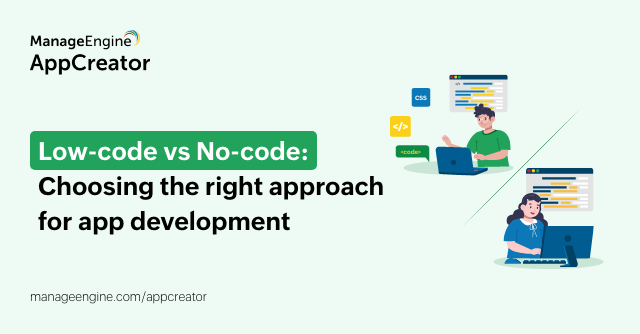- HOME
- Citizen development
- Unlocking the potential of citizen development with low-code
Unlocking the potential of citizen development with low-code
- Last Updated: May 29, 2025
- 393 Views
- 5 Min Read

Citizen development is a process that allows non-IT business users to build custom business applications without formal programming training or experience. It empowers individuals within an organization to create solutions that address specific business needs and pain points. One of the key enablers of citizen development is the use of low-code, which provides graphical user interfaces and intuitive drag-and-drop tools for citizen application development.
The rise of citizen development
In today's digital age, organizations are constantly looking for ways to improve operational efficiency, promote agility, and drive innovation. However, the demand for application development often surpasses the capacity of IT teams, leading to bottlenecks and delays. This is where citizen development comes into play. By empowering non-IT employees to build applications—and in turn becoming citizen developers—organizations can leverage the skills and domain knowledge of their workforce to drive digital transformation.
Who are citizen developers?
A citizen developer is an individual within an organization who creates or develops software applications, tools, or solutions without formal training in software development. These individuals typically come from non-technical backgrounds and may have roles in various departments such as marketing, finance, operations, or customer support. A citizen developer leverages low-code or no-code platforms, which provide visual development interfaces and pre-built components, making it easier for non-technical users to build applications.
The benefits of citizen development
Organizations that offer encouragement and support for citizen development and citizen developers will enjoy several benefits. Firstly, it reduces the strain on IT teams by freeing them from routine and repetitive tasks, allowing them to focus on more complex and strategic projects. This not only increases the productivity and efficiency of IT teams but also accelerates the pace of digital transformation within the organization.
Secondly, citizen application development promotes collaboration between business users and the IT department. By involving business users in the development process, organizations can ensure that applications are aligned with the specific needs of the business. This leads to the creation of more tailored and effective technology solutions that deliver value to the organization.
Some more benefits of a citizen development program include:
Rapid application development (RAD): Citizen development allows non-technical users to create applications quickly without relying on traditional development cycles. This accelerates the development process and enables faster responses to changing business needs and quicker solutions to business problems.
Business agility: Citizen development empowers business users to address their specific needs directly, reducing reliance on IT departments. This agility allows organizations to adapt to market changes and evolving requirements more swiftly.
Cost savings: By leveraging a citizen developer to create applications, organizations can potentially reduce the costs associated with hiring professional developers. This can be particularly advantageous for small to medium-sized businesses with budget constraints.
Increased innovation: Citizen development encourages creativity and innovation at the grassroots level. Frontline employees who intimately understand their workflow can develop solutions that better suit their specific needs, leading to more innovative and effective solutions.
Empowerment and engagement: Involving non-technical employees in the development process fosters a sense of empowerment and engagement. It allows individuals to take ownership of their work processes and build their own apps, leading to increased job satisfaction and motivation.
Reduced IT backlog: By enabling non-technical users to create and modify applications, IT departments can focus on more complex and strategic projects. This helps reduce the backlog of IT requests and allows IT professionals to concentrate on critical tasks.
Customization for specific needs: Citizen developers are often closer to the end-users and can create solutions tailored to specific business requirements. This customization ensures that applications align closely with the unique needs of the organization.
Enhanced collaboration: Citizen development often involves collaboration between different departments and teams. This cross-functional collaboration can lead to better communication, understanding, and alignment of goals across the organization.
Faster time-to-market: With citizen development, organizations can bring new applications and existing systems to market more quickly. This speed is crucial in industries where staying ahead of the competition is a key factor.
Scalability: As more employees become citizen developers, an organization can scale its capabilities to address a wider range of business processes and challenges.
The role of low-code platforms in citizen development
Low-code platforms play a crucial role in enabling a citizen development program. These platforms provide a simplified and intuitive app development and environment with drag-and-drop interfaces, pre-built templates, and reusable components. This platform allows citizen developers to quickly build applications without the need for extensive coding knowledge or experience.
The use of low-code development also significantly reduces the development time required for professional developers to create business applications. With pre-built templates and components, citizen developers can rapidly prototype and iterate on their ideas, leading to faster time-to-market and increased competitiveness for organizations.
Choosing the right low-code platform for a citizen developer
When it comes to selecting low-code platforms for citizen developers, there are several factors to consider. Firstly, the platform should have a user-friendly interface that is easy for non-technical users to navigate and understand. This ensures that a citizen developer can quickly get up to speed and start building applications without a steep learning curve.
Secondly, the platform should provide a wide range of pre-built app templates, components, and integrations. This allows citizen developers to leverage existing resources and accelerate the development process. Additionally, the low code development platform should support collaboration and enable seamless communication between citizen developers and IT teams, ensuring that the applications meet technical standards and can be effectively maintained and supported.
The future of citizen development in business processes
The future of citizen development looks promising, with the adoption of low-code platforms expected to continue to rise. As organizations strive to become more agile and responsive to market demands, citizen development will play an increasingly important role in driving digital transformation.
By empowering software developers to become citizen developers, organizations can tap into the creativity and problem-solving skills of their workforce, leading to the creation of innovative and customized solutions. With low-code platforms like ManageEngine AppCreator—that offer a supportive environment—citizen development has the potential to revolutionize the way applications are built and maintained within organizations.
In conclusion, citizen development and citizen developers, supported by low-code, present organizations the opportunity to leverage the skills and domain knowledge of their workforce to drive digital transformation. By involving a citizen developer in the development process, organizations can create tailored and effective solutions that address specific business requirements. As the demand for automation and new applications continues to grow, empowering citizen developers will become an essential part of the digital workplace.


